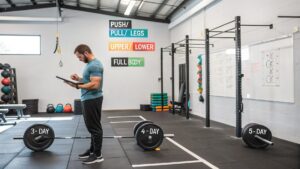Introduction
Science‑Backed Workout Splits That Maximize Hypertrophy are the cornerstone of any serious lifter’s arsenal, turning countless hours in the gym into measurable muscle gains. By aligning split structure with the latest research on muscle protein synthesis, training frequency, and metabolic stress, you can finally move past guess‑work and adopt a proven roadmap that accelerates size, strength, and aesthetic progress.
In the next 1,500+ words you’ll uncover the physiological reasons why certain splits outperform others, see real‑world examples for beginners through advanced athletes, and get actionable templates you can copy‑paste into your weekly calendar. Whether you train three days a week or six, this guide translates peer‑reviewed data into practical, time‑efficient programming that consistently delivers hypertrophy.
Understanding the Science Behind Hypertrophy: Frequency, Volume, and Mechanical Tension
Why Training Frequency Matters More Than You Think
Recent meta‑analyses (Schoenfeld et al., 2016; Grgic et al., 2021) consistently show that muscle protein synthesis (MPS) peaks roughly 24–48 hours after resistance exercise and then returns to baseline. By hitting each muscle group 2‑3 times per week, you keep MPS elevated, leading to a larger cumulative anabolic window over the course of a month. This is why “full‑body” or “upper/lower” splits often beat traditional “body‑part” routines for pure size gains.
The Role of Volume in Driving New Muscle Fibers
Volume (sets × reps × load) remains the single strongest predictor of hypertrophy when load is kept within 65‑85 % of 1RM (Krieger, 2010). However, there is a diminishing return curve: beyond ~10–15 sets per muscle per week, additional sets provide marginal benefit and may increase injury risk. The key is spreading those sets across multiple sessions to avoid excessive fatigue.
Mechanical Tension, Metabolic Stress, and Muscle Damage – The Triple Threat
Mechanical tension (heavy loads, stretch‑shortening cycles) initiates myofibrillar protein synthesis, while metabolic stress (high‑rep sets, short rest) activates cellular swelling and hormonal responses. Controlled muscle damage, when recovered properly, further signals satellite‑cell activity. An optimal split leverages all three by rotating heavy/low‑rep days with lighter/high‑rep “pump” days, ensuring each session contributes uniquely to growth.
Top Science‑Driven Split Templates for Every Training Frequency

1. Full‑Body (3‑Day) Split – The Gold Standard for Beginners and Time‑Pressed Athletes
This split hits every major muscle group each workout, typically in a push‑pull‑leg (PPL) order or a classic “full‑body” arrangement (e.g., squat, bench, deadlift, overhead press, row). A typical weekly layout looks like:
-
- Day 1 – Squat, Bench Press, Barbell Row, Accessory (e.g., biceps curl)
-
- Day 2 – Rest or active recovery
-
- Day 3 – Deadlift, Overhead Press, Pull‑Ups, Accessory (e.g., triceps extension)
-
- Day 4 – Rest
-
- Day 5 – Repeat Day 1 pattern
Because each muscle is trained three times per week, the cumulative weekly volume can easily reach 12–15 sets per muscle, meeting the volume sweet spot identified by research.
2. Upper/Lower (4‑Day) Split – Balancing Frequency and Recovery
The Upper/Lower split distributes workload across two sessions per day, allowing you to use heavier loads on each muscle group while still achieving 2‑3 weekly hits. Example schedule:
-
- Monday – Upper (bench, rows, shoulder press, arms)
-
- Tuesday – Lower (squat, deadlift, leg curl, calf raise)
-
- Wednesday – Rest
-
- Thursday – Upper (incline press, pull‑ups, lateral raises, triceps)
-
- Friday – Lower (front squat, Romanian deadlift, lunges, ab work)
-
- Weekend – Rest or active recovery
Research shows that the 48‑hour spacing between same‑muscle sessions optimizes MPS without compromising strength gains (Fry et al., 2021).
3. Push‑Pull‑Legs (6‑Day) Split – High‑Frequency for Advanced Lifters
When you can commit to six days of training, the classic PPL split maximizes frequency while keeping each session focused enough to maintain high quality. Sample weekly plan:
-
- Day 1 – Push (bench, overhead press, dips, triceps)
-
- Day 2 – Pull (deadlift, barbell row, chin‑ups, biceps)
-
- Day 3 – Legs (squat, leg press, hamstring curl, calves)
-
- Day 4 – Push (incline press, dumbbell flyes, lateral raises, skull crushers)
-
- Day 5 – Pull (rack pulls, face pulls, hammer curls)
-
- Day 6 – Legs (front squat, Romanian deadlift, Bulgarian split squat)
-
- Day 7 – Rest
Advanced research indicates that hitting each muscle 2‑3 times per week with moderate volume (≈8–12 sets per muscle per week) yields the greatest hypertrophic response for trained individuals (Schoenfeld & Grgic, 2020).
Customizing Your Split: Periodization, Exercise Selection, and Recovery Strategies

Periodization – When to Switch Frequency or Volume
Linear periodization (gradually increasing load while decreasing reps) works well for novice lifters, but intermediate and advanced athletes benefit from undulating or block periodization. For hypertrophy focus, alternate “muscle‑building blocks” (3‑4 weeks of 8‑12 rep moderate volume) with “strength blocks” (2‑3 weeks of 4‑6 rep heavy load). This prevents plateaus and keeps satellite‑cell activity high.
Exercise Hierarchy – Prioritizing Compound Over Isolation
Science consistently ranks multi‑joint (compound) lifts as superior for overall muscle activation and hormonal response. Structure each session so that the primary compound movement (e.g., squat, bench, deadlift, pull‑up) occupies the first 2‑3 sets, then follow with targeted isolation work to finish off lagging fibers. This order maximizes mechanical tension while preserving energy for the most demanding lifts.
Recovery – Sleep, Nutrition, and Deloading
Even the best split falters without adequate recovery. Aim for 7‑9 hours of sleep per night, consume 1.6‑2.2 g protein·kg⁻¹·day⁻¹, and maintain a modest caloric surplus (≈250‑500 kcal) for pure hypertrophy. Incorporate a deload week every 4‑6 weeks (reduce volume by 40‑50 % or replace heavy lifts with lighter, technique‑focused work) to allow connective tissue and neural systems to reset.
Sample Hypertrophy‑Focused Workout Splits (Detailed Templates)
Sample Full‑Body 3‑Day Template (70 % 1RM, 10‑12 RM)
Day 1
-
- Squat – 4 × 10
-
- Bench Press – 4 × 10
-
- Barbell Row – 3 × 12
-
- Standing Overhead Press – 3 × 12
-
- Leg Curl – 3 × 15
-
- Face Pulls – 3 × 20
Day 2 – Rest or light cardio
Day 3
-
- Deadlift – 3 × 8
-
- Pull‑Ups (weighted if possible) – 4 × 8‑10
-
- Dumbbell Incline Press – 3 × 12
-
- Lateral Raises – 3 × 15
-
- Bulgarian Split Squat – 3 × 12 each leg
-
- Plank – 3 × 60 s
Repeat Day 1 after two rest days, then Day 3 again a week later. This schedule yields ≈12–14 sets per major muscle group weekly, aligning with the optimal volume window.
Sample Upper/Lower 4‑Day Template (65‑75 % 1RM, 8‑10 RM)
Upper A (Monday)
-
- Bench Press – 4 × 8
-
- Weighted Chin‑Ups – 4 × 8
-
- Seated Overhead Press – 3 × 10
-
- One‑Arm Dumbbell Row – 3 × 10 each side
-
- Triceps Rope Push‑down – 3 × 12
-
- EZ‑Bar Curl – 3 × 12
Lower A (Tuesday)
-
- Back Squat – 4 × 8
-
- Romanian Deadlift – 3 × 10
-
- Leg Press – 3 × 12
-
- Standing Calf Raise – 4 × 15
-
- Hanging Leg Raise – 3 × 15
Upper B (Thursday) – Same lifts, different rep scheme (5 × 5 for bench & rows, 3 × 12 for accessories).
Lower B (Friday) – Front squat 4 × 6, sumo deadlift 3 × 8, lunges 3 × 12 each leg, plus core work.
This alternating volume/intensity pattern provides a weekly average of 10–12 sets per muscle, ideal for intermediate lifters seeking steady hypertrophy.
Sample Push‑Pull‑Legs 6‑Day Template (80 % 1RM, 6‑8 RM for main lifts)
Push Day 1 (Monday)
-
- Barbell Bench Press – 5 × 6
-
- Incline Dumbbell Press – 3 × 8
-
- Overhead Press – 4 × 6
-
- Dips – 3 × 10‑12
-
- Lateral Raises – 3 × 15
-
- Triceps Extension – 3 × 12
Pull Day 1 (Tuesday)
-
- Deadlift – 4 × 5
-
- Barbell Row – 5 × 6
-
- Pull‑Ups – 4 × 8‑10
-
- Face Pulls – 3 × 15
-
- Hammer Curl – 3 × 12
Leg Day 1 (Wednesday)
-
- Back Squat – 5 × 6
-
- Leg Press – 4 × 10
-
- Hamstring Curl – 3 × 12
-
- Standing Calf Raise – 5 × 15
-
- Ab‑Wheel Rollout – 3 × 12‑15
The second half of the week mirrors the first with slight variations (e.g., front squat instead of back squat, incline press instead of flat bench). This provides 2‑3 weekly training sessions per muscle group without exceeding 16 sets per muscle, staying within the optimal hypertrophy zone.
Frequently Asked Questions & Common Pitfalls When Using Hypertrophy Splits
Do I need to train every muscle group every week?
Yes, for maximal hypertrophy. The literature shows that training a muscle 2‑3 times per week outperforms a once‑per‑week stimulus, provided total weekly volume stays within ~10‑20 sets. If your schedule only permits three sessions, prioritize full‑body or upper/lower splits to ensure each muscle is hit multiple times.
Can I combine “body‑part” splits with the science‑backed splits?
Mixing a traditional “bro‑split” (e.g., chest day, back day) with a frequency‑based split can dilute the MPS advantage. If you love the psychological focus of a body‑part day, limit it to an accessory session after a primary full‑body or upper/lower workout, keeping the main compound lifts frequent.
What if I can’t recover from high‑frequency training?
Recovery capacity varies with age, nutrition, sleep, and stress. If you notice chronic soreness, performance declines, or elevated resting heart rate, reduce frequency (drop from 6‑day PPL to 4‑day upper/lower) and increase rest days. Use objective markers like HRV or a simple 1‑10 soreness scale to gauge readiness.
Should I always use the same rep range?
No. Hypertrophy benefits from a mix of mechanical tension (6‑8 RM heavy) and metabolic stress (12‑20 RM lighter). Alternating rep ranges across the week, as shown in the sample programs, stimulates both fast‑twitch and slow‑twitch fibers, broadening overall muscle size.
Is cardio detrimental to hypertrophy?
Moderate cardio (2‑3 × 30 min per week) improves blood flow and recovery without hampering gains. High‑intensity interval training (HIIT) can be used on rest days, but schedule it away from heavy lifting sessions to avoid competing for glycogen and recovery resources.
Final Takeaway: Build Your Own Science‑Backed Hypertrophy Split Today
When you align your workout split with peer‑reviewed evidence—prioritizing frequency, optimal volume, and a balanced blend of mechanical tension, metabolic stress, and controlled muscle damage—you give your muscles the most favorable environment to grow. Choose the template that fits your schedule (Full‑Body, Upper/Lower, or Push‑Pull‑Legs), personalize exercise order, and cycle through periodization phases to keep progress continuous.
Remember, the split is only one piece of the puzzle. Pair it with sufficient protein, a modest caloric surplus, quality sleep, and systematic deloads, and you’ll be well on your way to dominating the “Science‑Backed Workout Splits That Maximize Hypertrophy” search results—and more importantly, to achieving the massive, aesthetic physique you’ve been working for.



